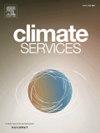Too hot to handle: Assessing practitioner climate service needs to advance heat resilience
IF 4.5
3区 环境科学与生态学
Q2 ENVIRONMENTAL SCIENCES
引用次数: 0
Abstract
Extreme heat is deadly and it is disproportionately experienced by lower-income, minority, and marginalized community members. Heat practitioners are faced with the dual challenges of taking action to mitigate the level of heat experienced by local residents while preparing communities to manage unavoidable levels of elevated warming. In response to a lack of in-depth information about heat practitioner needs, this work aims to advance our understanding of how efforts to improve climate services may contribute to more effective extreme heat planning and decision-making in the United States. Through a two-round, mixed-methods approach that employed group interviews and a survey, we engaged with 144 heat practitioners from 40 states and Washington, DC. We found that the biggest barriers to extreme heat planning and implementation are a lack of perceived risk and a lack of internal staff capacity, and that practitioners would welcome additional heat related information and tools. The two practitioner “needs” that respondents considered to be most impactful are: regularly updated local-scale extreme heat data collection, and improved information about how extreme heat impacts different systems. We found significant differences in the perceived impactfulness of interventions based on whether a respondent was from a rural or urban area and also based on their level of educational attainment.
Practical implications
Climate-induced extreme heat is deadly and disproportionately impacts lower-income, minority, and marginalized community members. People working for local and regional governments are responsible for making decisions and implementing actions to reduce the impacts of extreme heat in their communities. Those tasked with that work are referred to here as heat practitioners. To understand their needs we conducted a series of interviews and a survey that engaged over 140 heat practitioners from 40 states and Washington, DC. In this paper we share our findings that bring an in-depth understanding of climate service needs specific to those working to protect people from extreme heat.
An important finding from our work is that climate services cannot be just about more information, there is a need for building adaptive capacity and support to overcome complex barriers. Specifically we see a clear need to address the silos heat practitioners find themselves in. Additionally, by elevating the importance of heat within communities practitioners will have an easier time working to manage and mitigate this threat.
We find a strong call for better information that is tailored to local contexts. Heat practitioners said that the most impactful thing that would benefit their work is updated local-scale extreme heat data collection and on-the-ground monitoring. Another highly localized data need was information about the relationship between urban design and extreme heat. We also heard that information should be about specific actions heat practitioners could take to address this threat. One specific example is the request for information about the relative effectiveness of nature-based solutions.
Heat practitioners also noted that translation of information was crucial for their work. They specifically note a need for translations that connect extreme heat to risk. For example heat practitioners consider a regionally specific heat index as potentially having a high level of impact which indicates the need for translation efforts. The need for translation is also made clear when we hear quotes like “Instead of giving me the data, show me what I can do with the data.”
Finally, we observed a need for climate services to be specific to the circumstances of different places. Respondents working in urban areas were more likely to indicate that additional information would be impactful to their work. This difference could be addressed by developing information that is more clearly tailored to and relevant for rural areas. Additionally, we observed different needs between those with postgraduate education and those with bachelor’s degrees or less. This education divide could be addressed by improved access to education as well as different types of information provided to each group. Heat practitioners were somewhat siloed into those that focus on mitigating heat and those that focus on management of heat. This could be addressed by both working to bridge these two groups and by developing services specific to each type of heat practitioner.
太热无法处理:评估从业者气候服务需要提高热恢复能力
极端高温是致命的,低收入、少数民族和边缘化社区成员尤其容易遭受极端高温。供暖从业者面临着双重挑战,既要采取行动减轻当地居民的高温水平,又要让社区做好准备,应对不可避免的升温水平。由于缺乏关于热量从业者需求的深入信息,这项工作旨在提高我们对如何努力改善气候服务可能有助于美国更有效的极端热量规划和决策的理解。通过采用小组访谈和调查的两轮混合方法,我们与来自40个州和华盛顿特区的144名供热从业人员进行了接触。我们发现,极端高温规划和实施的最大障碍是缺乏对风险的感知和内部人员能力的缺乏,从业者希望获得更多与高温相关的信息和工具。受访者认为最具影响力的两个从业者“需求”是:定期更新本地极端高温数据收集,以及改进极端高温如何影响不同系统的信息。我们发现,根据受访者来自农村还是城市地区,以及他们的受教育程度,干预措施的感知影响存在显著差异。气候引起的极端高温是致命的,对低收入、少数民族和边缘化社区成员的影响尤为严重。地方和地区政府的工作人员负责制定决策和实施行动,以减少极端高温对社区的影响。负责这项工作的人在这里被称为热从业者。为了了解他们的需求,我们进行了一系列访谈和调查,涉及来自40个州和华盛顿特区的140多名供暖从业者。在本文中,我们分享了我们的发现,这些发现使我们深入了解了那些致力于保护人们免受极端高温侵害的人的气候服务需求。我们工作的一个重要发现是,气候服务不能仅仅是提供更多信息,还需要建立适应能力和支持,以克服复杂的障碍。具体来说,我们认为有必要解决供热从业者所处的困境。此外,通过提高社区内热量的重要性,从业者将更容易管理和减轻这一威胁。我们发现人们强烈要求根据当地情况提供更好的信息。供热从业人员表示,对他们的工作最有影响的是更新当地极端高温数据收集和实地监测。另一个高度本地化的数据需求是关于城市设计与极端高温之间关系的信息。我们还听说,信息应该是关于从业者可以采取的具体行动,以解决这一威胁。一个具体的例子是要求提供关于基于自然的解决办法的相对有效性的信息。热从业人员还指出,信息翻译对他们的工作至关重要。他们特别指出,需要将极端高温与风险联系起来。例如,热从业者认为区域特定的热指数可能具有高水平的影响,这表明需要进行翻译工作。当我们听到“与其给我数据,不如告诉我我能用数据做什么”这样的话时,翻译的必要性也很明显。最后,我们观察到需要针对不同地方的具体情况提供气候服务。在城市地区工作的答复者更有可能表示,额外的信息将对他们的工作产生影响。这种差异可以通过编制更明确地适合农村地区并与农村地区相关的信息来解决。此外,我们观察到研究生学历和本科及以下学历的人的需求不同。这种教育差距可以通过改善受教育机会以及向每一群体提供不同类型的信息来解决。热量从业者在某种程度上被分为那些专注于减轻热量和那些专注于热量管理的人。这可以通过在这两个群体之间架起桥梁来解决,也可以通过开发针对每种类型的热从业者的特定服务来解决。
本文章由计算机程序翻译,如有差异,请以英文原文为准。
求助全文
约1分钟内获得全文
求助全文
来源期刊

Climate Services
Multiple-
CiteScore
5.30
自引率
15.60%
发文量
62
期刊介绍:
The journal Climate Services publishes research with a focus on science-based and user-specific climate information underpinning climate services, ultimately to assist society to adapt to climate change. Climate Services brings science and practice closer together. The journal addresses both researchers in the field of climate service research, and stakeholders and practitioners interested in or already applying climate services. It serves as a means of communication, dialogue and exchange between researchers and stakeholders. Climate services pioneers novel research areas that directly refer to how climate information can be applied in methodologies and tools for adaptation to climate change. It publishes best practice examples, case studies as well as theories, methods and data analysis with a clear connection to climate services. The focus of the published work is often multi-disciplinary, case-specific, tailored to specific sectors and strongly application-oriented. To offer a suitable outlet for such studies, Climate Services journal introduced a new section in the research article type. The research article contains a classical scientific part as well as a section with easily understandable practical implications for policy makers and practitioners. The journal''s focus is on the use and usability of climate information for adaptation purposes underpinning climate services.
 求助内容:
求助内容: 应助结果提醒方式:
应助结果提醒方式:


